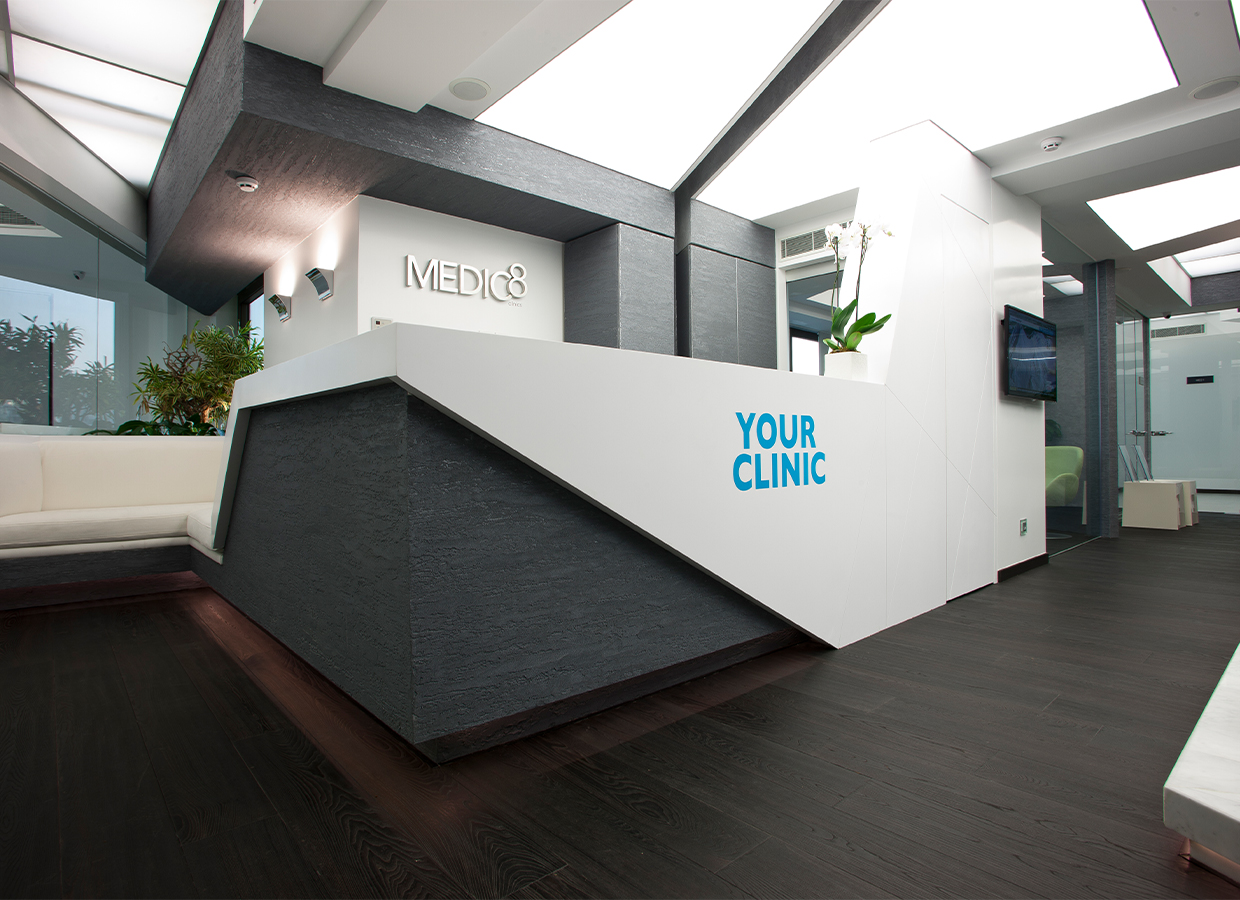

Cosmetic Dentistry
Medic8clinics Computerized dentistry veneers
Medic8clinics Computerized dentistry veneers, a New High-End Patent Trademark of computerized cosmetic dentistry.
The technique is simple, we need generally 2 sessions: we take an impression for your natural teeth (without drilling), done at our Medic8 Digital lab, then after 3 to 5 days only we do the placement of these very high-quality aesthetic veneers.
Medic8clinics veneers can be made as thin as (0.3mm) while being very resistant, of 30% more resistant than any other Hollywood smile makeover technique.
Our dental specialists design every case individually depending on the shape and shade of the normal teeth, the shape of the lips and face and the preference of the patient, to attain a perfectly natural result.
Medic8clinics provides a certificate for every patient who opt for a smile makeover as well as a 5 International years’ warranty.Veneers
Veneers are thin lenses of porcelain used to recreate the natural look of teeth, while also providing strength, resilience and translucency comparable to natural tooth enamel. It is often the best option for those looking to make minimal position alterations or to change the shape, size, or have a permanent white color.
Advantages of having porcelain veneers:
Look & feel natural – Made to match your natural teeth
Strength & durability – strong, durable material
Long lasting solution – Last 7 to 10 years
Quick, simple – completed within two, or three visits
Stain-resistant – resistant to staining, coffee, smoking, food colorants
Confidence
Two years warrantyComposite Veneers
Due to the variety of dentin and enamel bonding agents that are currently available, the direct application of composite resin can now be performed with success and predictability.
Recent advances in composite resin formulation such as enhanced strength, wear, stability, aesthetics, and ease of manipulation, expanded indications for direct techniques.
Polychromatic direct composite veneers can be placed in a single appointment.
Zirconium
In dentistry, there has been continuous research and development to find materials suitable for dental prosthesis that are aesthetically acceptable and has sufficient strength to withstand the forces of chewing.
Besides, they must be well tolerated by the human body.
For many years ceramic materials combined with metals have been used in dental restorations – ceramic gives the desired aesthetics and metal is used for strength.
Advantages of Zirconium:
• High crack resistance. If a material is stressed, it may crack. The unusual feature of zirconium oxide ceramic in comparison with other ceramics is that at the appearance of a high-tension area a transformation of the crystal structure can take place and by this volume increase it builds wedges in the crack and therefore it reduces the continuation of the crack.
• Translucency that is very similar to a natural tooth. Light is reflected from a Zirconium crown in much the same way. This means that Zirconium will produce the best aesthetic effect, which is important if your new crowns are to be at the front. It is particularly the case when the crowns will be seen beside natural teeth.
• Fully biocompatible so there are no risks of allergic reactions. It is increasingly being used in general surgery as well as in dentistry.
CAD CAM
Medic8clinics affiliated dental clinics introduces the most advanced CAD (Computer Aided Design) – CAM (Computer Aided Manufacturing) technologies.
The CAD/CAM technologies are used to produce different types of dental restorations, including crowns, veneers, inlays and onlays, fixed bridges, dental implant restorations and orthodontic appliances.
The computer program displays a 3D custom image of teeth, allowing to precisely design the tooth restoration with functional and aesthetic characteristics. Once the computer and cosmetic dentist have designed the restoration, the information is sent to a sculpting machine (milling), which creates the restoration to the exact specifications of the design through CAM.
There is no need for impression taking, temporaries or unnecessary reduction of healthy tooth structure. The technology is so precise that dental restorations made by CAD/CAM often fit better than those made by hand in a dental lab.
Smile Makeover
A smile makeover involves one or more cosmetic, dental or facial rejuvenation procedures to improve the aesthetics of your smile. Often, smile makeovers are a combination of procedures, such as straightening teeth, repairing a chipped or broken tooth, replacing missing teeth, re-contouring gums, whitening discolored teeth and other cosmetic dentistry procedures.
There are many different ways in which you can improve your smile using modern cosmetic dentistry:
• Chipped, broken teeth can be repaired. The treatment will depend on the extent of damage, but the options include cosmetic bonding, porcelain veneers or porcelain crowns.
• Crooked teeth can be straightened. With Invisalign braces or conventional orthodontics. Orthodontic treatment can also rejuvenate your facial appearance by reshaping the jaw, neck and lips, especially when combined with maxillofacial surgical procedures. They can also be covered with porcelain veneers for a faster solution, often referred to as “instant orthodontics”.
• Missing teeth can be replaced. They can cause functional problems as well as being unsightly. Solutions include dental implants, a dental bridge or a denture.
• Gaps between your teeth can be closed to give you a better smile. This can be achieved instantly with porcelain veneers or Lumineers. Orthodontics can also be used to move the teeth and close the gaps between them.
Orthodontics
Braces
Dental braces are devices used to align and straighten teeth. They are often used to correct underbites, overbites malocclusions, open bites, deep bites, cross bites,] and various other flaws of the teeth and jaw.
Braces can be either cosmetic or structural. Dental braces are often used in conjunction with other orthodontic appliances to force and pressure on the teeth, widen the palate or jaws and shaping the teeth and jaws.
We at Medic8clinics, provide a range of teeth straightening options.Damon system braces
They are made from the same materials as traditional braces. However, these braces do not require the use of elastics, which means, fewer appointments and less friction being placed on the tooth. Self-ligating braces come with traditional metal, ceramic, or clear brackets. They use a specialized clip in place of elastics to help the archwire guide teeth into place. The clip helps reduce the amount of pressure being placed on the tooth, and requires fewer adjustments because there are no elastics to replace.
Clear or ceramic braces
Serve as a cosmetic alternative to traditional metal braces, by blending into the natural color of the teeth. Typically, these brackets are made of ceramic function in a similar manner to traditional metal brackets. Clear elastic ties and white metal ties are available to be used with these clear braces to help keep the appliances less conspicuous.
Lingual braces: Eline system
They are a cosmetic alternative to traditional metal braces, except that the brackets and wires are placed on the inside of teeth making them externally invisible.
Invisible teeth straightening process
For your benefit, at our clinic, your orthodontic problem can be corrected with Progressive Clear Removable Aligners
starlynr® Aligner
Oral Surgery
Dental Implants
Endodontic Dentistry
Endodontic
If your tooth has been heavily filled, cracked or decayed, this may lead to pain, infection or darkening of your tooth. If any of these symptoms occur, then there’s a possibility that your tooth requires root canal treatment; Also known as endodontic treatment or root canal therapy.
Microscopic Endo
Root canal treatment at Medic8clinics, is a virtually pain free way to eliminate the often agonizing pain of an infected or highly inflamed tooth, and may helps to prevent worsening pain or infection. It is a highly skilled area of dentistry, and generally using the laser to complete an EndoLase procedure which provides very conservative treatment of the anatomy of the inside of the tooth, that is why Laser Endo and Microscopic Endo are options at our clinics for conservative treatment and best results.
Advantages of Microscope
Optical quality
A dental microscope is at its core an optical instrument, which allows the dentist to see enhanced details in order to work as precisely as possible. Therefore, there should be no compromise concerning the optical components. Only superior optical quality with excellent clarity offers high resolution, large depth of field, and maximum light transmission. This is indispensable for a successful root canal treatment as the root canals are in most cases not rectilinear and have cavities and tiny ramifications, which are difficult to detect without high magnification and depth of field. Accurate color representation is also required for easy differentiation of anatomical details.
Documentation
Today, videos and images play an ever-increasing role within the dental practice for many reasons.
Firstly, during a procedure, live on-screen video can help the assistant to support the dental surgeon.
Secondly, video is a useful training tool either during or post treatment, additionally, it can be shared with the wider dental community online or at seminars.
Thirdly, video can support patient relationships and trust, as the dentist can show the patient what he sees which take them through the steps of a procedure and thus include them in consultation and treatment.
Finally, video and images can be included in a patient’s file for more thorough documentation and to facilitate easy review. Ease of transfer to a practice documentation system and the ability to save different file formats are therefore further key considerations.Whitening
Bleaching
Teeth bleaching or whitening is among the most popular cosmetic dental procedures. It’s a simple, non-invasive dental treatment used to change the color of natural tooth enamel and is an ideal way to enhance the beauty of your smile. Teeth whitening techniques are not permanent. A touch-up may be needed every several years.
Pediatric Dentistry
Pediatric dentists are dedicated to the oral health of children from infancy through the teen years. They have the experience and qualifications to care for a child’s teeth, gums, and mouth throughout the various stages of childhood.
Children begin to get their baby teeth during the first 6 months of life.
By age 6 or 7 years, they start to lose their first set of teeth, which eventually are replaced by secondary, permanent teeth.
